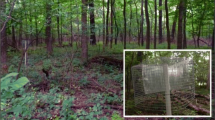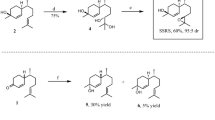Abstract
We studied the foraging behavior ofRhagoletis cerasi females in trees treated with synthetic cherry fruit fly host marking pheromone (HMP) under seminatural conditions (potted trees enclosed in a screen cage). Results show that synthetic HMP (particularly the 8RS-@#@ 15R isomer configuration (racemic mixture)) was highly effective in eliciting behavioral responses similar to those reported in studies using natural HMP. Flies exposed to synthetic pheromone exhibited short tree residence times (i.e., emigrated faster), increased flight frequency rates (measured as number of alightings per/minute), higher irritation indices while on a tree or a fruit, and oviposited fewer eggs per fruit visit than flies exposed to clean trees and fruit (not treated with synthetic HMP). Furthermore, we provide evidence showing that when flies were continuously exposed to an HMP-saturated environment, they exhibited an increased tendency to lay eggs in marked fruit.
Similar content being viewed by others
References
Aluia, M., andBoller, E.F. 1992. Host marking pheromone ofRhagoletis cerasi: Field deployment of synthetic pheromone as a novel cherry fruit fly management strategy.Entomol. Exp. Appl. In press.
Aluja, M., Prokopy, R.J., Elkinton, J.S., andLaurence, F. 1989. Novel approach for tracking and quantifying the movement patterns of insects in three dimensions under seminatural conditions.Environ. Entomol. 18:1–7.
Averill, A.L., andProkopy, R.J. 1989a. Host marking pheromones, pp. 207–219,in A.S. Robinson and G. Hooper (eds.). Fruit Flies, Their Biology, Natural Enemies and Control. Elsevier, Amsterdam.
Averill, A.L., andProkopy, R.J. 1989b. Distribution patterns ofRhagoletis pomonella (Diptera: Tephritidae) eggs in hawthorn.Ann. Entomol. Soc. Am. 82:38–44.
Boller, E.F. 1981. Oviposition-deterring pheromone of the European cherry fruit fly: Status of research and potential applications, pp. 457–462,in E.R. Mitchell (ed.). Management of Insect Pests with Semiochemicals: Concepts and Practice. Plenum Press, New York.
Boller, E.F., andAluja, M. 1992. Oviposition deterring pheromone ofRhagoletis cerasi: biological activity of 4 synthetic isomers and HMP discrimination of two host races as measured by an improved laboratory bioassay.Z. Angew. Entomol. 113:113–119.
Boller, E.F., andHurter, J. 1985. Oviposition deterring pheromone inRhagoletis cerasi: Behavioral laboratory test to measure pheromone activity.Entomol. Exp. Appl. 39:163–169.
Boller, E.F., Schoni, R., andBush, G.L. 1987. Oviposition deterring pheromone inRhagoletis cerasi: Biological activity of a pure single compound verified in semi-field test.Entomol. Exp. Appl. 45:17–22.
Bowdan, E. 1984. Electrophysiological responses of tarsal contact chemoreceptors of the apple maggot flyRhagoletis pomonella to salt, sucrose and oviposition-deterring pheromone.J. Comp. Physiol. A 154:143–152.
Cirio, U. 1972. Osservazioni sul comportamento di oviposizione dellaRhagoletis completa in laboratorio. Proceedings, 9th Congress of the Italian Entomology Society (Sienna), pp. 99–117.
Ernst, B., andWagner, B. 1989. Synthesis of the oviposition-deterring pheromone (ODP) inRhagoletis cerasi L.Helv.Chim. Acta 72:165–171.
Girolami, V., Vianello, A., Strapazzon, A., Ragazzi, E., andVeronese, G. 1981. Ovipositional deterrents inDacus oleae.Entomol. Exp. Appl. 29:177–188.
Hurter, J., Boller, E.F., Stadler, E., Blattman, H., Buser, R., Bosshard, N.U., Damm, L., Kozlowski, M.W., Schoni, R., Raschdorf, F., Dahinden, R., Schlumpf, E., Fritz, H., Richter, W.J., andSchreiber, J. 1987. Oviposition-deterring pheromone inRhagoletis cerasi L.: purification and determination of the chemical constitution.Experientia 43:157–164.
Katsoyannos, B.I. 1975. Oviposition-deterring, male-arresting, fruit marking pheromone inRhagoletis cerasi L.Environ.Entomol. 4:801–807.
Papaj, D.R., Roitberg, B.D., andOpp, S.B. 1989. Serial effects of host infestation on egg allocation by the Mediterranean fruit fly: A rule of thumb and its functional significance.J. Anim. Ecol. 58:955–970.
Papaj, D.R., Roitberg, B.D., Opp, S.B., Aluja, M., Prokopy, R.J., andWong, T.T.Y. 1990. Effect of marking pheromone on clutch size in the Mediterranean fruit fly.Physiol. Entomol. 15:463–468.
Prokopy, R.J. 1972. Evidence for a marking pheromone deterring repeated oviposition in apple flies.Environ. Entomol. 1:326–332.
Prokopy, R.J. 1981. Oviposition-deterring pheromone system of apple maggot flies, pp. 477–494,in E.R. Mitchell (ed.). Management of Insect Pests with Semiochemicals: Concepts and Practice. Plenum Press, New York.
Prokopy, R.J., andBush, G.L. 1972. Mating behavior inRhagoletis pomonella. III. Male aggregation in response to an arrestant.Can. Entomol. 104:275–283.
Remund, U., andBoller, E.F. 1975. Entwicklung und Auswendungsmöglichkeiten einer neuen visuellen Falle für die Kirschenfliege,Rhagoletis cerasi L.Z. Angew. Entomol. 77:348–353.
Roitberg, B.D., andProkopy, R.J. 1981. Experience required for pheromone recognition in the apple maggot fly.Nature 292:540–541.
Roitberg, B.D., andProkopy, R.J. 1983. Host deprivation influence on responseof Rhagoletis pomonella to its oviposition deterring pheromone.Physiol. Entomol. 8:69–72.
Roitberg, B.D., andProkopy, R.J. 1984. Host visitation sequence as a determinant of search persistence in fruit parasitic tephritid flies.Oecologia (Berlin) 62:7–12.
Roitberg, B.D., andProkopy, R.J. 1987. Insects that mark host plants.BioScience 37:400–406.
Roitberg, B.D., Van Lenteren, J.C., Van Alphen, J.J., Galis, F., andProkopy, R.J. 1982. Foraging behavior ofRhagoletis pomonella, a parasite of hawthorn (Crataegus viridis), in nature.J. Anim. Ecol. 51:307–325.
Roitberg, B.D., Cairl, R.S., andProkopy, R.J. 1984. Oviposition deterring pheromone influences dispersal distance in tephritid fruit flies.Entomol. Exp. Appl. 35:217–220.
Stadler, E., andKatsoyannos, B.I. 1979. Das Markierungspheromon der Kirschenfliege: Erste elektrophysiologische Untersuchungen der Sinnesorgane.Mitt. Schweiz. Entomol. Ges. 52:444.
Städler, E., Schoni, R., andKozlowski, M.W. 1987. Relative air humidity influences the function of the tarsal chemoreceptor cells of the cherry fruit fly (Rhagoletis cerasi).Physiol. Entomol. 12:339–346.
Statgraphics (Statistical Graphics Corp.). 1986. Statistical Graphics System, Version 2.1.
Author information
Authors and Affiliations
Rights and permissions
About this article
Cite this article
Aluja, M., Boller, E.F. Host marking pheromone ofRhagoletis cerasi: Foraging behavior in response to synthetic pheromonal isomers. J Chem Ecol 18, 1299–1311 (1992). https://doi.org/10.1007/BF00994357
Received:
Accepted:
Issue Date:
DOI: https://doi.org/10.1007/BF00994357




